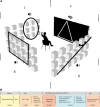Shape detection beyond the visual field using a visual-to-auditory sensory augmentation device
- PMID: 36936618
- PMCID: PMC10017858
- DOI: 10.3389/fnhum.2023.1058617
Shape detection beyond the visual field using a visual-to-auditory sensory augmentation device
Abstract
Current advancements in both technology and science allow us to manipulate our sensory modalities in new and unexpected ways. In the present study, we explore the potential of expanding what we perceive through our natural senses by utilizing a visual-to-auditory sensory substitution device (SSD), the EyeMusic, an algorithm that converts images to sound. The EyeMusic was initially developed to allow blind individuals to create a spatial representation of information arriving from a video feed at a slow sampling rate. In this study, we aimed to use the EyeMusic for the blind areas of sighted individuals. We use it in this initial proof-of-concept study to test the ability of sighted subjects to combine visual information with surrounding auditory sonification representing visual information. Participants in this study were tasked with recognizing and adequately placing the stimuli, using sound to represent the areas outside the standard human visual field. As such, the participants were asked to report shapes' identities as well as their spatial orientation (front/right/back/left), requiring combined visual (90° frontal) and auditory input (the remaining 270°) for the successful performance of the task (content in both vision and audition was presented in a sweeping clockwise motion around the participant). We found that participants were successful at a highly above chance level after a brief 1-h-long session of online training and one on-site training session of an average of 20 min. They could even draw a 2D representation of this image in some cases. Participants could also generalize, recognizing new shapes they were not explicitly trained on. Our findings provide an initial proof of concept indicating that sensory augmentation devices and techniques can potentially be used in combination with natural sensory information in order to expand the natural fields of sensory perception.
Keywords: auditory spatial perception; multisensory perception; multisensory spatial perception; sensory substitution; sensory substitution device (SSD); spatial perception; visual-auditory; visual-spatial perception.
Copyright © 2023 Shvadron, Snir, Maimon, Yizhar, Harel, Poradosu and Amedi.
Conflict of interest statement
The authors declare that the research was conducted in the absence of any commercial or financial relationships that could be construed as a potential conflict of interest.
Figures





Similar articles
-
The Topo-Speech sensory substitution system as a method of conveying spatial information to the blind and vision impaired.Front Hum Neurosci. 2023 Jan 26;16:1058093. doi: 10.3389/fnhum.2022.1058093. eCollection 2022. Front Hum Neurosci. 2023. PMID: 36776219 Free PMC article.
-
A self-training program for sensory substitution devices.PLoS One. 2021 Apr 27;16(4):e0250281. doi: 10.1371/journal.pone.0250281. eCollection 2021. PLoS One. 2021. PMID: 33905446 Free PMC article.
-
Sensory Substitution: The Spatial Updating of Auditory Scenes "Mimics" the Spatial Updating of Visual Scenes.Front Behav Neurosci. 2016 Apr 21;10:79. doi: 10.3389/fnbeh.2016.00079. eCollection 2016. Front Behav Neurosci. 2016. PMID: 27148000 Free PMC article.
-
Multisensory perceptual learning and sensory substitution.Neurosci Biobehav Rev. 2014 Apr;41:16-25. doi: 10.1016/j.neubiorev.2012.11.017. Epub 2012 Dec 7. Neurosci Biobehav Rev. 2014. PMID: 23220697 Review.
-
Representing colour through hearing and touch in sensory substitution devices.Multisens Res. 2013;26(6):503-32. doi: 10.1163/22134808-00002434. Multisens Res. 2013. PMID: 24800410 Review.
Cited by
-
A brief reference to AI-driven audible reality (AuRa) in open world: potential, applications, and evaluation.Front Artif Intell. 2024 Oct 25;7:1424371. doi: 10.3389/frai.2024.1424371. eCollection 2024. Front Artif Intell. 2024. PMID: 39525498 Free PMC article.
-
Perceiving depth beyond sight: Evaluating intrinsic and learned cues via a proof of concept sensory substitution method in the visually impaired and sighted.PLoS One. 2024 Sep 25;19(9):e0310033. doi: 10.1371/journal.pone.0310033. eCollection 2024. PLoS One. 2024. PMID: 39321152 Free PMC article.
-
The Topo-Speech sensory substitution system as a method of conveying spatial information to the blind and vision impaired.Front Hum Neurosci. 2023 Jan 26;16:1058093. doi: 10.3389/fnhum.2022.1058093. eCollection 2022. Front Hum Neurosci. 2023. PMID: 36776219 Free PMC article.
References
LinkOut - more resources
Full Text Sources
Research Materials

